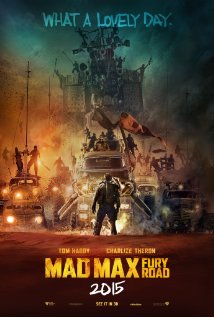"Mad Max: Fury Road" is Director George Miller's fourth film in his post-apocalyptic franchise, and is part sequel, part reboot, and all mad.
Preceded by "Mad Max" (1979), "The Road Warrior" (1981), and "Mad Max: Beyond Thunderdome" (1985), "Fury Road" takes place at some unspecified time after the last movie, but is most similar in spirit to "The Road Warrior." In fact, the movie is essentially one long car chase, with a couple of restless rest stops.
But you don't need to know the original backstory, which is fortunate because none is provided, aside from periodic flashbacks - the visions and voices that haunt Max's head. There's a new replacement for Mel Gibson's Max Rockatansky to meet anyway (Tom Hardy), and a co-starring ass-kicker (another hero?) Imperator Furiosa (Charlize Theron).
Things don't begin well for Max, as he's captured by a group of War Boys who serve the warlord Immortan Joe (Hugh Keays-Byrne), tyrant ruler of the Citadel. There are four rationed fluids that life depends upon in the Citadel -- water, gasoline, blood, and milk -- and its society is structured around them in creatively unpleasant ways.

As rushed and reticent as the movie is, there is an efficient use of space for character development, perhaps most movingly in the character of Nux (Nicholas Hoult), who is an enthusiastic member of the War Boy death cult ("I live, I die, I live again"). Max, who is given less room to develop (and doesn't need it, as he's always in a type of psychological solitary confinement) spends half the movie just trying to remove his chains and iron face mask. He needs Furiosa as much as she needs him, though it's Furiosa who, literally and figuratively, is behind the wheel. The feminist strain is played out further by the Five Wives, escaped "breeders" whose message is clearly left behind for Immortan Joe: "We are not things." He offers a different perspective: "That's my property."
The beautifully brutal wasteland of Namibia replaces the beautifully brutal wasteland of Australia, and is hardly background scenery. It figures so prominently as both a physical space and mental state, that it can be considered a major character.
Though it depicts a dystopic nightmare, "Fury Road" doesn't take itself too seriously. The movie has a sense of humor, albeit a dark one, displayed by characters such as a guitarist/flamethrower bouncing from a bungee cord, accompanied by a truckload of percussionists. Together they create a soundtrack for lost souls.
It is not surprising for Mad Max to go off road, but the franchise has never quite gone in this direction before. Max advises Furiosa: "Hope is a mistake." If that's true, then it's a mistake to watch "Fury Road," because it's hard not to hope it won't end.
| Movie title | Mad Max: Fury Road |
|---|---|
| Release year | 2015 |
| MPAA Rating | R |
| Our rating | |
| Summary | The fourth film in this post-apocalyptic franchise is part sequel, part reboot, and all mad. |